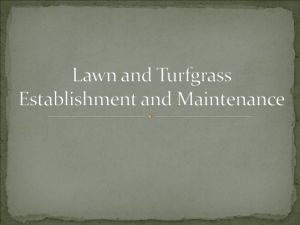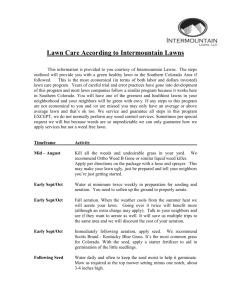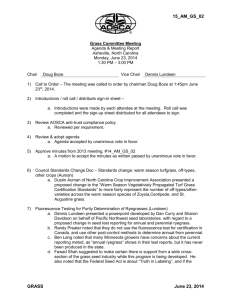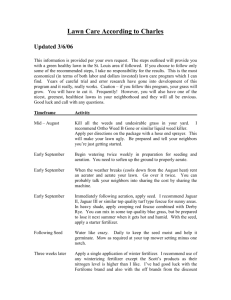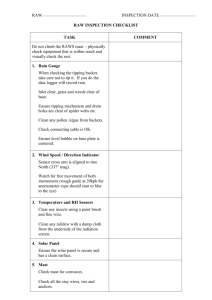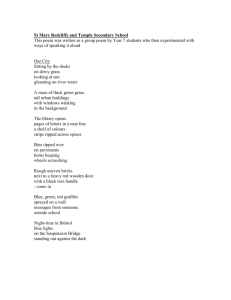Below are answers to commonly
advertisement
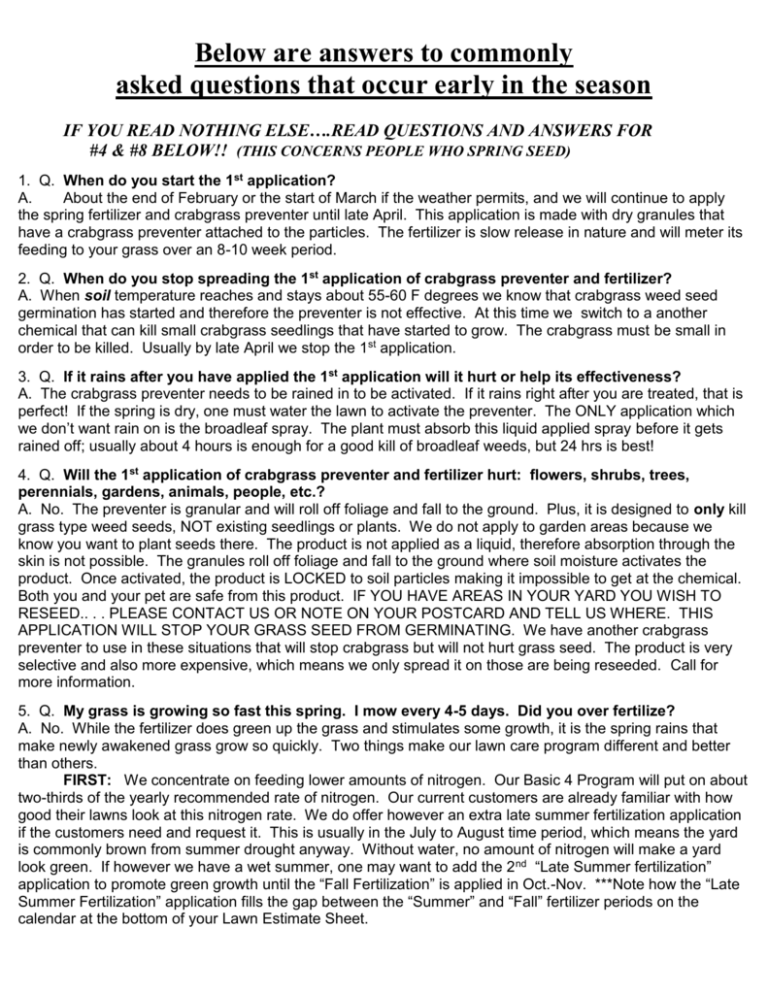
Below are answers to commonly asked questions that occur early in the season IF YOU READ NOTHING ELSE….READ QUESTIONS AND ANSWERS FOR #4 & #8 BELOW!! (THIS CONCERNS PEOPLE WHO SPRING SEED) 1. Q. When do you start the 1st application? A. About the end of February or the start of March if the weather permits, and we will continue to apply the spring fertilizer and crabgrass preventer until late April. This application is made with dry granules that have a crabgrass preventer attached to the particles. The fertilizer is slow release in nature and will meter its feeding to your grass over an 8-10 week period. 2. Q. When do you stop spreading the 1st application of crabgrass preventer and fertilizer? A. When soil temperature reaches and stays about 55-60 F degrees we know that crabgrass weed seed germination has started and therefore the preventer is not effective. At this time we switch to a another chemical that can kill small crabgrass seedlings that have started to grow. The crabgrass must be small in order to be killed. Usually by late April we stop the 1st application. 3. Q. If it rains after you have applied the 1st application will it hurt or help its effectiveness? A. The crabgrass preventer needs to be rained in to be activated. If it rains right after you are treated, that is perfect! If the spring is dry, one must water the lawn to activate the preventer. The ONLY application which we don’t want rain on is the broadleaf spray. The plant must absorb this liquid applied spray before it gets rained off; usually about 4 hours is enough for a good kill of broadleaf weeds, but 24 hrs is best! 4. Q. Will the 1st application of crabgrass preventer and fertilizer hurt: flowers, shrubs, trees, perennials, gardens, animals, people, etc.? A. No. The preventer is granular and will roll off foliage and fall to the ground. Plus, it is designed to only kill grass type weed seeds, NOT existing seedlings or plants. We do not apply to garden areas because we know you want to plant seeds there. The product is not applied as a liquid, therefore absorption through the skin is not possible. The granules roll off foliage and fall to the ground where soil moisture activates the product. Once activated, the product is LOCKED to soil particles making it impossible to get at the chemical. Both you and your pet are safe from this product. IF YOU HAVE AREAS IN YOUR YARD YOU WISH TO RESEED.. . . PLEASE CONTACT US OR NOTE ON YOUR POSTCARD AND TELL US WHERE. THIS APPLICATION WILL STOP YOUR GRASS SEED FROM GERMINATING. We have another crabgrass preventer to use in these situations that will stop crabgrass but will not hurt grass seed. The product is very selective and also more expensive, which means we only spread it on those are being reseeded. Call for more information. 5. Q. My grass is growing so fast this spring. I mow every 4-5 days. Did you over fertilize? A. No. While the fertilizer does green up the grass and stimulates some growth, it is the spring rains that make newly awakened grass grow so quickly. Two things make our lawn care program different and better than others. FIRST: We concentrate on feeding lower amounts of nitrogen. Our Basic 4 Program will put on about two-thirds of the yearly recommended rate of nitrogen. Our current customers are already familiar with how good their lawns look at this nitrogen rate. We do offer however an extra late summer fertilization application if the customers need and request it. This is usually in the July to August time period, which means the yard is commonly brown from summer drought anyway. Without water, no amount of nitrogen will make a yard look green. If however we have a wet summer, one may want to add the 2 nd “Late Summer fertilization” application to promote green growth until the “Fall Fertilization” is applied in Oct.-Nov. ***Note how the “Late Summer Fertilization” application fills the gap between the “Summer” and “Fall” fertilizer periods on the calendar at the bottom of your Lawn Estimate Sheet. SECOND: The fertilizer we use is slow release in nature. Cheaper granular or even liquid applied nitrogen so common with the larger chain lawncare companies will give a short lived burst of growth. Since the nitrogen only lasts 4-6 weeks, you end up with 6-7 applications, rather than only 4 with our Basic 4 application program. Our fertilizer will give a metered release of nitrogen throughout its lifespan of 8-12 weeks. The spring slow release fertilizer lasts a shorter period than the summer slow release fertilizer because there is usually more rainfall in the spring. 6. Q. Will this application kill dandelions? A. NO. It only stops grass type weed seeds from germinating. Preventing seeds from even getting started best controls annual grassy weeds, like crabgrass (the number one weed enemy). If you skip this application, by the time the crabgrass is big enough for most people to see, it is already too difficult to kill. We can apply a Post-emerge product, but it can only kill a small crabgrass weed up to the 3-5 tiller stage. Killing the dandelions and other broadleaf weeds is done by actually spraying the weed itself, when it is actively growing. In the early spring, (before April 15th), the broadleaf weeds are growing so slowly that a good kill is harder to get. It is best to wait until it warms up and growth is rapid. 7. Q. When is a good time to core my lawn? A. Spring or fall. At the bottom of your estimate sheet is a yearly calendar that tells the best time for certain applications or procedures to take place. 8. Q. When is a good time to seed my yard? A. Spring or fall, with fall being the best. There is less weed competition in the fall. If you do decide to seed in the spring, let us know, for we need to switch to a different crabgrass control product. The usual crabgrass control product would kill your grass seed. We also have interseeders that do an outstanding job of putting seed into the ground. This gives the seed excellent soil to seed contact and will give much better results than scattering seed (birdseed!!) on the soil surface. 9. Q. What about mowing? A. One: Keep a sharp blade. Very much an overlooked condition. Turf WILL APPEAR BROWN A DAY OR TWO AFTER BEING MOWED WITH A DULL BLADE. I KNOW. I GET CALLS THAT THINK IT MAY BE SPRAY DAMAGE! It will grow out of it, so in the mean time, sharpen the blade. Two: Never remove more than 1/3 of the blade of grass at a time or too much shock on the grass plant’s system may occur. If you mow too closely and remove more than the 1/3 in the heat of the summer, severe damage can occur. I KNOW. I GET CALLS THAT THINK IT IS SPRAY DAMAGE! Three: Don’t mow it shorter than 2 ¾” tall. Three to 3 ½” is even better. The taller the grass, the deeper the roots. The shorter the grass, the more shallow the roots. Guess which one stays green longer in the summer? Taller grass also shades the soil surface making it cooler in the summer. With all this healthy, tall, thick, choking grass, that lets little sunlight hit the soil surface, a poor weed seed laying there in the “dark” has a hard time becoming established. This means fewer weeds, less broadleaf spraying, less cost to you, and a better-looking lawn. 10. Q. How can I get rid of moles? A. There are many methods and home remedies that exist. However most are time consuming and require a certain element of luck. To date, the use of caster oil appears to be our most convenient and effective method of chasing moles out of your lawn. University studies have verified that this application does indeed work. Until now, liquid applications were our only choice. Metering the proper amount of caster oil applied and getting water to the spot to be treated made liquid applications difficult. We NOW have available a GRANULAR caster oil product that makes application both effective and efficient. The product can be applied to wet or dry soil and is harmless to pets, people, and surrounding landscape plants. Natural rainfall or irrigation will activate the product. Depending of infestation, 1-3 applications per year may be necessary. Please call us if you have any more questions. Thank You (309)-772-9517

